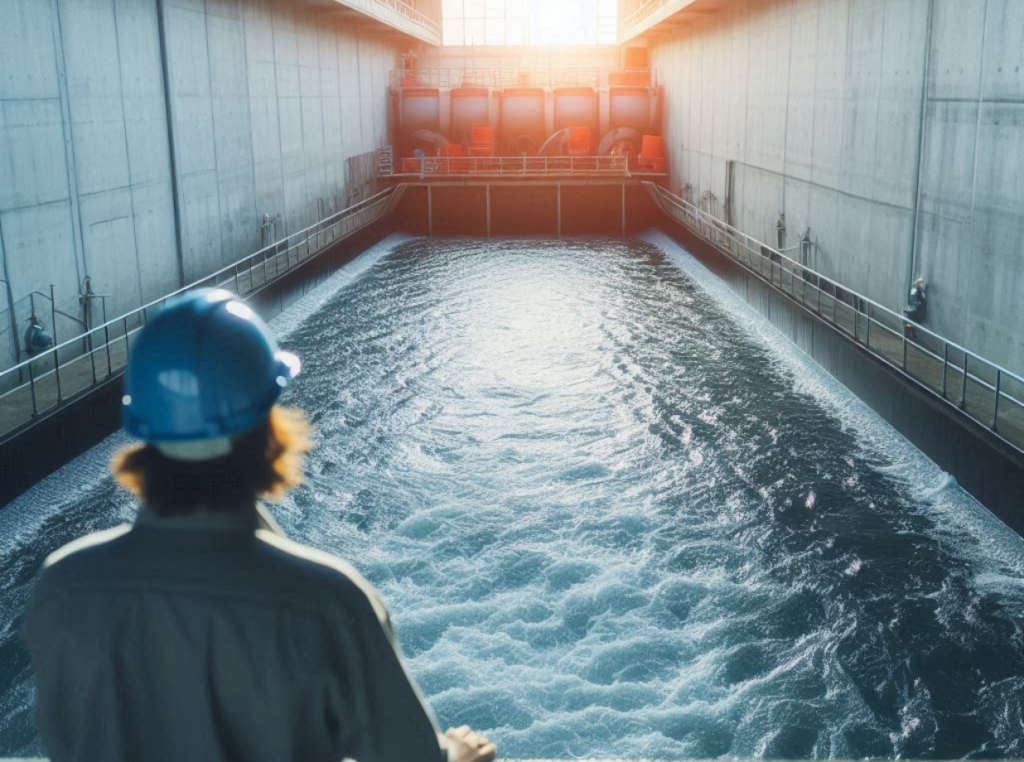Introduction
Wastewater treatment is a vital process for maintaining public health, protecting the environment, and ensuring the sustainability of water resources. As population growth and industrial activities increase the demand for water, the proper treatment of wastewater becomes more critical. Secondary treatment is one of the most important steps in this process, responsible for removing the dissolved and suspended organic matter that remains after primary treatment.

In this guide, we’ll explore what secondary treatment entails, why it’s necessary, and how it fits into the larger framework of wastewater treatment. We will also look at the various biological processes used in secondary treatment, the control mechanisms required to maintain system performance, common challenges, and innovative technologies shaping the future of wastewater management.
Overview of the Wastewater Treatment Process
Primary Treatment
The wastewater treatment process begins with primary treatment, a mechanical phase that removes large particles, floating materials, and heavy solids from the wastewater. This step involves techniques like screening, sedimentation, and skimming. While primary treatment is effective at removing around 50-60% of total suspended solids (TSS) and reducing pollutants like oils and grease, it does not adequately address dissolved organic matter. This is where secondary treatment comes in.
Secondary Treatment
Secondary treatment is designed to remove biodegradable organic matter and suspended solids left after primary treatment. It focuses on biological processes that use microorganisms to consume organic pollutants in wastewater, breaking them down into simpler substances like carbon dioxide, water, and biomass.
Tertiary Treatment
Following secondary treatment, some wastewater facilities employ tertiary treatment to further polish the effluent. This stage often involves advanced filtration, disinfection, and nutrient removal processes to meet stringent regulatory standards for water quality.
Key Concepts in Secondary Treatment
Biochemical Oxygen Demand (BOD)
A crucial concept in secondary treatment is Biochemical Oxygen Demand (BOD), which measures the amount of oxygen microorganisms need to break down organic material in water. The higher the BOD, the greater the concentration of biodegradable organic matter in the wastewater. Secondary treatment systems aim to reduce BOD levels by removing these pollutants through microbial action, ensuring that the effluent discharged into water bodies does not deplete dissolved oxygen levels, which can harm aquatic life.
Activated Sludge Process
The activated sludge process is the cornerstone of secondary treatment in many wastewater treatment plants (WWTPs). In this process, wastewater is aerated in a tank to encourage the growth of aerobic microorganisms that digest organic material. These microorganisms form clumps called flocs, which can be easily separated from the treated water in a settling tank.
Effluent Quality Standards
Effluent discharged from wastewater treatment plants must meet specific quality standards to protect public health and the environment. Secondary treatment typically reduces the BOD by 85-95%, lowers TSS to acceptable levels, and minimizes other pollutants like ammonia. The treated effluent must meet these standards before it is either discharged into a water body or sent for further treatment.
Biological Treatment Methods
Secondary treatment processes can be broadly categorized into two types: suspended growth systems and attached growth systems.
Suspended Growth Systems
Activated Sludge Process
The activated sludge process is the most common form of secondary treatment. It involves aerating wastewater in a tank to promote the growth of microorganisms that feed on the organic pollutants. The key components of the activated sludge system are:
- Aeration Tank: Wastewater is mixed with air, which provides oxygen to support microbial activity. Microorganisms feed on the organic matter, breaking it down into carbon dioxide, water, and new cell mass.
- Clarifier (Settling Tank): After aeration, the mixture of wastewater and biomass (known as mixed liquor) flows into a clarifier, where the solids settle to the bottom, separating clean water from the sludge.
- Sludge Recycling: A portion of the settled sludge, called return activated sludge (RAS), is recirculated back into the aeration tank to maintain the microbial population. The rest, known as waste activated sludge (WAS), is sent for further treatment or disposal.
Activated sludge processes can be classified into different types based on the operational conditions, such as conventional activated sludge, extended aeration, and oxidation ditches. These systems differ mainly in terms of aeration time, sludge age, and the organic load they can handle.
Sequencing Batch Reactor (SBR)
The Sequencing Batch Reactor (SBR) is a variation of the activated sludge process that operates in batch mode. Instead of a continuous flow system, SBR treats wastewater in cycles within the same tank. Each cycle consists of five phases:
- Fill: Wastewater is introduced into the tank.
- React (Aeration): Aeration begins, allowing microorganisms to break down the organic matter.
- Settle: Aeration stops, and solids are allowed to settle at the bottom of the tank.
- Draw (Decant): The treated water is removed from the top of the tank.
- Idle: The system is idle until the next batch is introduced.
SBR systems are highly flexible, allowing for the adjustment of reaction times to accommodate varying influent conditions. They are often used in smaller wastewater treatment plants or plants with fluctuating wastewater volumes.
Attached Growth Systems
Trickling Filters
In trickling filters, wastewater is sprayed over a bed of media (such as rocks, plastic, or other materials) that provides a surface for microorganisms to grow. As wastewater flows over the media, the microorganisms degrade the organic pollutants. The treated water is collected at the bottom of the filter and sent to a clarifier for further settling of any remaining solids. Trickling filters are simple, low-energy systems but may not achieve the same level of treatment as activated sludge processes.
Rotating Biological Contactors (RBCs)
Rotating Biological Contactors (RBCs) are another type of attached growth system. In RBCs, a series of discs are partially submerged in wastewater and rotate slowly. Microorganisms grow on the surface of the discs and break down the organic matter as the discs rotate in and out of the water, allowing for both aeration and contact with the wastewater. RBCs are effective for small to medium-sized wastewater treatment plants and are known for their simplicity and reliability.
Process Controls in Secondary Treatment

Effective process control is critical for maintaining optimal performance in secondary treatment systems. Several key parameters must be carefully monitored and controlled.
Mixed Liquor Suspended Solids (MLSS) and Mixed Liquor Volatile Suspended Solids (MLVSS)
In the activated sludge process, the concentration of solids in the aeration tank, known as Mixed Liquor Suspended Solids (MLSS), is a key operational parameter. The Mixed Liquor Volatile Suspended Solids (MLVSS) fraction represents the portion of the MLSS that is composed of living microorganisms. Maintaining an appropriate MLSS concentration is important for achieving efficient treatment.
Sludge Retention Time (SRT) and Mean Cell Residence Time (MCRT)
The Sludge Retention Time (SRT), also known as Mean Cell Residence Time (MCRT), refers to the average amount of time that microorganisms remain in the treatment system. Controlling the SRT is crucial for maintaining a stable microbial population. A longer SRT allows more time for microorganisms to break down complex organic compounds, while a shorter SRT may lead to the washout of microorganisms and poor treatment performance.
Aeration Control
Aeration is a critical component of secondary treatment processes, particularly in activated sludge systems. Adequate oxygen supply is necessary for aerobic microorganisms to metabolize organic pollutants. Aeration control systems use dissolved oxygen sensors to maintain the optimal oxygen concentration in the aeration tank, balancing the need for efficient treatment with energy consumption.
Challenges in Secondary Treatment
Bulking Sludge and Pin Floc
Bulking sludge is a common operational issue in activated sludge systems, where the microbial flocs do not settle properly in the clarifier, leading to poor separation of solids from the treated water. This can be caused by filamentous bacteria that grow excessively and interfere with floc formation. Pin floc, on the other hand, refers to small, fine flocs that settle too slowly, resulting in cloudy effluent.
Nutrient Removal (Nitrogen and Phosphorus)
Secondary treatment processes are effective at removing organic matter, but they are not always designed to remove nutrients such as nitrogen and phosphorus, which can contribute to eutrophication in receiving waters. Some advanced secondary treatment systems incorporate Biological Nutrient Removal (BNR) processes to address this issue. These systems use specialized bacteria to remove nitrogen through nitrification and denitrification, and phosphorus through enhanced biological phosphorus removal (EBPR).
Importance of Microbial Activity
Microbial Communities
The performance of secondary treatment systems depends heavily on the health and diversity of the microbial communities involved. In activated sludge systems, bacteria, protozoa, and metazoans all play essential roles in breaking down organic matter. The presence of a balanced and healthy microbial community ensures that the system operates efficiently.
Indicators of System Health
Operators can assess the health of a secondary treatment system by observing microbial activity and performing routine testing. Key indicators include:
- Floc Formation: Healthy microbial communities form well-settling flocs.
- Dissolved Oxygen (DO): Adequate oxygen levels are necessary for aerobic treatment.
- Oxygen Uptake Rate (OUR): Measures the rate at which microorganisms consume oxygen, indicating their activity level.
- Sludge Volume Index (SVI): Assesses the settleability of sludge in the clarifier.
Advancements in Secondary Treatment Technology
Membrane Bioreactors (MBRs)
Membrane Bioreactors (MBRs) are an innovative technology that combines biological treatment with membrane filtration. In MBR systems, the mixed liquor is passed through a membrane to separate treated water from solids, eliminating the need for a clarifier. MBRs provide high-quality effluent, making them ideal for facilities that require advanced treatment or have limited space.
Moving Bed Biofilm Reactors (MBBRs)
Moving Bed Biofilm Reactors (MBBRs) are a hybrid system that combines aspects of both suspended growth and attached growth processes. In MBBRs, small plastic carriers with a large surface area are suspended in the aeration tank, providing a surface for biofilm growth. This allows for increased microbial activity without the need for a large aeration tank or settling tank.
Advanced Process Controls
With the rise of automation and digital monitoring systems, advanced process control technologies are becoming more prevalent in wastewater treatment. Sensors and data analytics allow operators to optimize performance, reduce energy consumption, and predict maintenance needs more accurately.
Conclusion
Secondary treatment is the backbone of modern wastewater treatment systems, transforming polluted water into a cleaner effluent that can be safely discharged into the environment. Through biological processes like the activated sludge system, sequencing batch reactors, trickling filters, and rotating biological contactors, wastewater treatment plants remove the majority of organic pollutants, protecting water resources and public health.
With ongoing advancements in technology, the future of secondary treatment looks promising. Innovations such as membrane bioreactors and moving bed biofilm reactors are pushing the boundaries of what is possible, while data-driven process controls are helping operators maintain efficiency and performance.
Whether you are a wastewater operator, an environmental engineer, or simply someone interested in the protection of water resources, understanding secondary treatment is key to appreciating the vital role wastewater treatment plays in modern society.ment capabilities. Understanding secondary treatment is key to appreciating wastewater treatment’s vital role in society.
Resources
- U.S. Environmental Protection Agency (EPA) – Wastewater Treatment Overview: EPA Wastewater
- Water Environment Federation (WEF) – Secondary Treatment: WEF Secondary Treatment
- American Water Works Association (AWWA): AWWA Wastewater
- National Association of Clean Water Agencies (NACWA): NACWA
- World Health Organization (WHO) – Water, Sanitation, and Hygiene: WHO WASH
These resources provide further insights into wastewater treatment practices, policies, and emerging technologies for those interested in deepening their understanding of secondary treatment.
